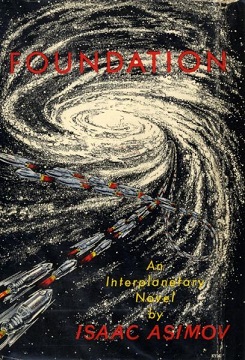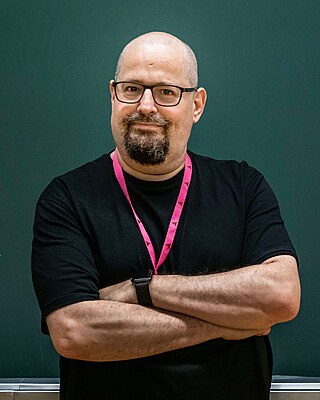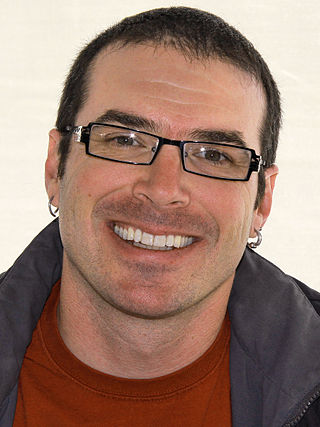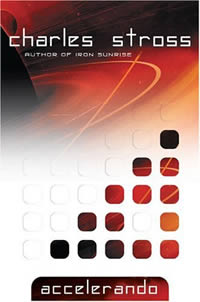Nightfall or night fall may refer to:

Foundation is a science fiction novel by American writer Isaac Asimov. It is the first book in the Foundation Trilogy. Foundation is a cycle of five interrelated short stories, first published as a single book by Gnome Press in 1951. Collectively they tell the early story of the Foundation, an institute founded by psychohistorian Hari Seldon to preserve the best of galactic civilization after the collapse of the Galactic Empire.

Ted Chiang is an American science fiction writer. His work has won four Nebula awards, four Hugo awards, the John W. Campbell Award for Best New Writer, and six Locus awards. He has published the short story collections Stories of Your Life and Others (2002) and Exhalation: Stories (2019). His short story "Story of Your Life" was the basis of the film Arrival (2016). He was an artist in residence at the University of Notre Dame in 2020–2021. Chiang is also a frequent non-fiction contributor to the New Yorker Magazine, most recently on topics related to computer technology, such as artificial intelligence.

Charles David George "Charlie" Stross is a British writer of science fiction and fantasy. Stross specialises in hard science fiction and space opera. Between 1994 and 2004, he was also an active writer for the magazine Computer Shopper and was responsible for its monthly Linux column. He stopped writing for the magazine to devote more time to novels. However, he continues to publish freelance articles on the Internet.

Singularity Sky is a science fiction novel by British writer Charles Stross, published in 2003. It was nominated for the Hugo Award for Best Novel in 2004. A sequel, Iron Sunrise, was published that same year. Together the two are referred to as the Eschaton novels, after a near-godlike intelligence that exists in both.
A matrioshka brain is a hypothetical megastructure of immense computational capacity powered by a Dyson sphere. It was proposed in 1997 by Robert J. Bradbury (1956–2011). It is an example of a class-B stellar engine, employing the entire energy output of a star to drive computer systems. This concept derives its name from the nesting Russian matryoshka dolls. The concept was deployed by Bradbury in the anthology Year Million: Science at the Far Edge of Knowledge.

Esther Mona Friesner-Stutzman, née Friesner is an American science fiction and fantasy author. She is also a poet and playwright. She is best known for her humorous style of writing, both in the titles and the works themselves. This humor allows her to discuss with broader audiences issues like gender equality and social justice.
The Laundry Files is a series of novels by British writer Charles Stross. They mix the genres of Lovecraftian horror, spy thriller, science fiction, and workplace humour. Their main character for the first five novels is "Bob Howard", a one-time I.T. consultant turned occult field agent. Howard is recruited to work for the Q-Division of SOE, otherwise known as "the Laundry", the British government agency which deals with occult threats. "Magic" is described as being a branch of applied computation (mathematics), therefore computers and equations are just as useful, and perhaps more potent, than classic spellbooks, pentagrams, and sigils for the purpose of influencing ancient powers and opening gates to other dimensions. These occult struggles happen largely out of view of the public, as the Laundry seeks to keep the methods for contacting such powers under wraps. There are also elements of dry humour and satirisation of bureaucracy.

James Patrick Kelly is an American science fiction author who has won both the Hugo Award and the Nebula Award.

Sarah Bear Elizabeth Wishnevsky is an American author who works primarily in speculative fiction genres, writing under the name Elizabeth Bear. She won the 2005 John W. Campbell Award for Best New Writer, the 2008 Hugo Award for Best Short Story for "Tideline", and the 2009 Hugo Award for Best Novelette for "Shoggoths in Bloom". She is one of a small number of writers who have gone on to win multiple Hugo Awards for fiction after winning the John W. Campbell Award for Best New Writer.

Paolo Tadini Bacigalupi is an American science fiction and fantasy writer. He has won the Hugo, Nebula, John W. Campbell Memorial, Compton Crook, Theodore Sturgeon, and Michael L. Printz awards, and has been nominated for the National Book Award. His fiction has appeared in The Magazine of Fantasy & Science Fiction, Asimov's Science Fiction, and the environmental journal High Country News. Nonfiction essays of his have appeared in Salon.com and High Country News, and have been syndicated in newspapers, including the Idaho Statesman, the Albuquerque Journal, and The Salt Lake Tribune.

Glasshouse is a science fiction novel by British author Charles Stross, first published in 2006.

Saturn's Children is a 2008 science fiction novel by British author Charles Stross. Stross called it "a space opera and late-period [Robert A.] Heinlein tribute", specifically to Heinlein's 1982 novel Friday.
Will McIntosh is a science fiction and young adult author, a Hugo-Award-winner, and a winner or finalist for many other awards. Along with ten novels, including Defenders,Love Minus Eighty, and Burning Midnight, he has published dozens of short stories in magazines such as Asimov's Science Fiction, Strange Horizons, Lightspeed Magazine, Clarkesworld, and Interzone. His stories are frequently reprinted in different "Year's Best" anthologies.
This is a list of the published works of Aliette de Bodard.
This is a list of books by British hard science fiction, Lovecraftian horror, and space opera author Charles Stross.

Sam J. Miller is an American science fiction, fantasy and horror short fiction author. His stories have appeared in publications such as Clarkesworld, Asimov's Science Fiction, and Lightspeed, along with over 15 "year's best" story collections. He was finalist for multiple Nebula Awards along with the World Fantasy and Theodore Sturgeon Awards. He won the 2013 Shirley Jackson Award for his short story "57 Reasons for the Slate Quarry Suicides." His debut novel, The Art of Starving, was published in 2017 and his novel Blackfish City won the 2019 John W. Campbell Memorial Award.

The Best of Harry Turtledove is a collection of science fiction short stories by American author Harry Turtledove. It was first published in hardcover and ebook by Subterranean Press in April 2021.
Suzanne Palmer is an American science fiction writer known for her novelette "The Secret Life of Bots", which won a Hugo Award for Best Novelette in 2018. The story also won a WSFA Small Press Award and was a finalist for the Theodore Sturgeon Award.












